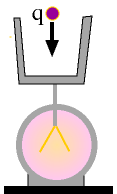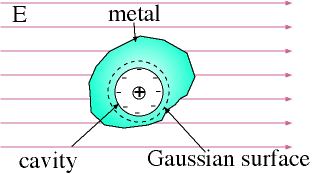Shielding, and other consequences of Gauss'
Law
We can immediately state the most important consequence of
Gauss' Law:
The electrostatic field
inside any isolated
conductor is always zero.
Suppose that at a given moment, this is not the situation. Then
there would be a net electric field wholly inside an isolated
conductor. This means that according to Gauss' Law there must be an
accumulation of net charge at some place inside the conducting body.
Now every conductor has free electrons inside it, which can move
rapidly due to this field and redistribute the charge. The
accumulated charge, therefore, due to mutual repulsion, gets away as
far as possible. It will move to the outer surface of the conductor,
leaving no net accumulation inside . The electric field then
becomes zero everywhere inside the conductor.
Franklin's Ice-pail Experiment:
 A
tall, cylindrical metal can (the 'ice pail') is put on the top of
a gold-leaf electroscope. The can is initially uncharged, so the
electroscope leaves show no divergence. A small metal sphere is
given some charge, and suspended by an insulating thread. Using
the thread, the sphere is lowered into the can, without touching
its inside surface. As it is lowered, the electroscope leaves
start diverging, showing the presence of charge on the can. Since
the sphere does not touch the can, this is obviously due to
induced charge on the inside of the can. To maintain charge
neutrality of the can, an equal and opposite charge appears on its
outside, causing divergence of the electroscope leaves.
A
tall, cylindrical metal can (the 'ice pail') is put on the top of
a gold-leaf electroscope. The can is initially uncharged, so the
electroscope leaves show no divergence. A small metal sphere is
given some charge, and suspended by an insulating thread. Using
the thread, the sphere is lowered into the can, without touching
its inside surface. As it is lowered, the electroscope leaves
start diverging, showing the presence of charge on the can. Since
the sphere does not touch the can, this is obviously due to
induced charge on the inside of the can. To maintain charge
neutrality of the can, an equal and opposite charge appears on its
outside, causing divergence of the electroscope leaves.- If the outside of the can is now grounded for a second, the
outside charges escape to the earth, and the leaves collapse. If
the sphere is now made to touch the inside of the can, there is
still no divergence. This shows that the induced opposite charge
is equal and opposite to the inducing charge on the sphere.
- Without the earth connection (grounding), if the sphere is
made to touch the inside of the can, the divergence of the leaves
remain the same. The reason for this is that the ball and the can
now form a single conductor, and the original charge on the ball
is transferred to the outside of the can. This is verified further
by taking the ball out and testing it for the presence of any
charge on it -- it shows no charge.
Electrostatic Shielding:
 If
a cavity is scooped out of a conducting body, the net charge, and
thus the electric field inside this cavity is always zero, no
matter how strongly the conductor is charged, or no matter in how
strong a field it is placed. We can show this impressively by placing
a metal and a plastic container on top of a Van de Graaff
generator:
If
a cavity is scooped out of a conducting body, the net charge, and
thus the electric field inside this cavity is always zero, no
matter how strongly the conductor is charged, or no matter in how
strong a field it is placed. We can show this impressively by placing
a metal and a plastic container on top of a Van de Graaff
generator:


|
|
[The big "Demo" button is for a large
video clip (typically 1 MB); and the small one for a version
reduced in size (typically 100 kB) and quality, but suitable
for download via phone lines].
|
The proof of this follows simply
from Gauss' law:
Take a closed Gaussian surface entirely surrounding the
cavity, wholly inside the metal. At each point of this surface the
field is zero. Therefore the net flux over this surface is also
zero. Therefore by Gauss' law, it follows that it encloses no
charge. Therefore the space inside the cavity is totally shielded
from any external influence.
 What
happens if you take a charge and enclose it completely by a metallic
body? You should be able to show by the same argument as above that
this induces bound charges on the inside surface of the cavity,
exactly equal in magnitude but opposite in sign as the original
charge.
What
happens if you take a charge and enclose it completely by a metallic
body? You should be able to show by the same argument as above that
this induces bound charges on the inside surface of the cavity,
exactly equal in magnitude but opposite in sign as the original
charge.
It is interesting to note that the conducting body could be quite
thin, and may even have holes in it. Faraday verified this by having
a cage made from wire grid, having it connected to electrostatic
machines producing high charge, while he himself was inside. Of
course, he was not affected at all.


|
|
[The big "Demo" button is for a large
video clip (typically 1 MB); and the small one for a version
reduced in size (typically 100 kB) and quality, but suitable
for download via phone lines].
|
©
MultiMedia Physics
2000
 A
tall, cylindrical metal can (the 'ice pail') is put on the top of
a gold-leaf electroscope. The can is initially uncharged, so the
electroscope leaves show no divergence. A small metal sphere is
given some charge, and suspended by an insulating thread. Using
the thread, the sphere is lowered into the can, without touching
its inside surface. As it is lowered, the electroscope leaves
start diverging, showing the presence of charge on the can. Since
the sphere does not touch the can, this is obviously due to
induced charge on the inside of the can. To maintain charge
neutrality of the can, an equal and opposite charge appears on its
outside, causing divergence of the electroscope leaves.
A
tall, cylindrical metal can (the 'ice pail') is put on the top of
a gold-leaf electroscope. The can is initially uncharged, so the
electroscope leaves show no divergence. A small metal sphere is
given some charge, and suspended by an insulating thread. Using
the thread, the sphere is lowered into the can, without touching
its inside surface. As it is lowered, the electroscope leaves
start diverging, showing the presence of charge on the can. Since
the sphere does not touch the can, this is obviously due to
induced charge on the inside of the can. To maintain charge
neutrality of the can, an equal and opposite charge appears on its
outside, causing divergence of the electroscope leaves. If
a cavity is scooped out of a conducting body, the net charge, and
thus the electric field inside this cavity is always zero, no
matter how strongly the conductor is charged, or no matter in how
strong a field it is placed. We can show this impressively by placing
a metal and a plastic container on top of a Van de Graaff
generator:
If
a cavity is scooped out of a conducting body, the net charge, and
thus the electric field inside this cavity is always zero, no
matter how strongly the conductor is charged, or no matter in how
strong a field it is placed. We can show this impressively by placing
a metal and a plastic container on top of a Van de Graaff
generator: What
happens if you take a charge and enclose it completely by a metallic
body? You should be able to show by the same argument as above that
this induces bound charges on the inside surface of the cavity,
exactly equal in magnitude but opposite in sign as the original
charge.
What
happens if you take a charge and enclose it completely by a metallic
body? You should be able to show by the same argument as above that
this induces bound charges on the inside surface of the cavity,
exactly equal in magnitude but opposite in sign as the original
charge.